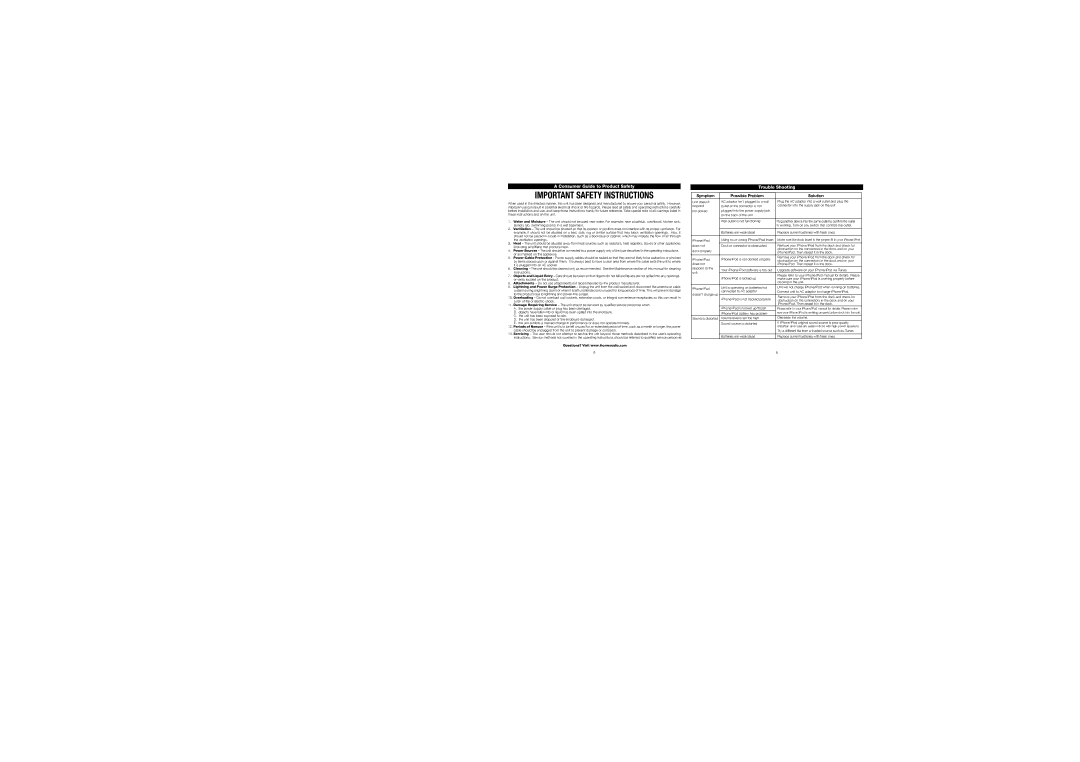A Consumer Guide to Product Safety
When used in the directed manner, this unit has been designed and manufactured to ensure your personal safety. However, improper use can result in potential electrical shock or fire hazards. Please read all safety and operating instructions carefully before installation and use, and keep these instructions handy for future reference. Take special note of all warnings listed in these instructions and on the unit.
1.Water and Moisture – The unit should not be used near water. For example: near a bathtub, washbowl, kitchen sink, laundry tub, swimming pool or in a wet basement.
2.Ventilation – The unit should be situated so that its location or position does not interfere with its proper ventilation. For example, it should not be situated on a bed, sofa, rug or similar surface that may block ventilation openings. Also, it should not be placed in a
3.Heat – The unit should be situated away from heat sources such as radiators, heat registers, stoves or other appliances (including amplifiers) that produce heat.
4.Power Sources – The unit should be connected to a power supply only of the type described in the operating instructions or as marked on the appliance.
5.
6.Cleaning – The unit should be cleaned only as recommended. See the Maintenance section of this manual for cleaning instructions.
7.Objects and Liquid Entry – Care should be taken so that objects do not fall and liquids are not spilled into any openings or vents located on the product.
8.Attachments – Do not use attachments not recommended by the product manufacturer.
9.Lightning and Power Surge Protection – Unplug the unit from the wall socket and disconnect the antenna or cable system during a lightning storm or when it is left unattended and unused for long periods of time. This will prevent damage to the product due to lightning and
10.Overloading – Do not overload wall sockets, extension cords, or integral convenience receptacles as this can result in a risk of fire or electric shock.
11.Damage Requiring Service – The unit should be serviced by qualified service personnel when:
A.the power supply cable or plug has been damaged.
B.objects have fallen into or liquid has been spilled into the enclosure.
C.the unit has been exposed to rain.
D.the unit has been dropped or the enclosure damaged.
E.the unit exhibits a marked change in performance or does not operate normally.
12.Periods of Nonuse – If the unit is to be left unused for an extended period of time, such as a month or longer, the power cable should be unplugged from the unit to prevent damage or corrosion.
13.Servicing – The user should not attempt to service the unit beyond those methods described in the user’s operating instructions. Service methods not covered in the operating instructions should be referred to qualified service personnel.
Questions? Visit www.ihomeaudio.com
8
Trouble Shooting
Symptom | Possible Problem | Solution | |
Unit doesn’t | AC adaptor isn’t plugged to a wall | Plug the AC adaptor into a wall outlet and plug the | |
respond | outlet or the connector is not | connector into the supply jack on the unit | |
(no power) | plugged into the power supply jack |
| |
| on the back of the unit |
| |
|
|
| |
| Wall outlet is not functioning | Plug another device into the same outlet to confirm the outlet | |
|
| is working. Turn on any switch that controls the outlet. | |
|
|
| |
| Batteries are weak/dead | Replace current batteries with fresh ones | |
|
|
| |
iPhone/iPod | Using no or wrong iPhone/iPod insert | Make sure the dock insert is the proper fit to your iPhone/iPod | |
does not | Dock or connector is obstructed | Remove your iPhone/iPod from the dock and check for | |
dock properly |
| obstruction on the connectors in the dock and on your | |
| iPhone/iPod. Then reseat it in the dock. | ||
|
| ||
iPhone/iPod | iPhone/iPod is not docked properly | Remove your iPhone/iPod from the dock and check for | |
obstruction on the connectors in the dock and on your | |||
does not |
| iPhone/iPod. Then reseat it in the dock. | |
respond to the | Your iPhone/iPod software is too old | Upgrade software on your iPhone/iPod via iTunes | |
unit | |||
|
| ||
iPhone/iPod is locked up | Please refer to your iPhone/iPod manual for details. Please | ||
| |||
| make sure your iPhone/iPod is working properly before | ||
|
| docking in the unit. | |
iPhone/iPod | Unit is operating on batteries/not | Unit will not charge iPhone/iPod when running on batteries. | |
connected to AC adaptor | Connect unit to AC adaptor to charge iPhone/iPod. | ||
doesn’t charge up | |||
|
| ||
iPhone/iPod is not docked properly | Remove your iPhone/iPod from the dock and check for | ||
| |||
| obstruction on the connectors in the dock and on your | ||
|
| ||
|
| iPhone/iPod. Then reseat it in the dock. | |
| iPhone/iPod is locked up/frozen | Please refer to your iPhone/iPod manual for details. Please make | |
| iPhone/iPod battery has problem | sure your iPhone/iPod is working properly before dock into the unit. | |
|
| ||
Sound is distorted | Volume level is set too high | Decrease the volume. | |
| Sound source is distorted | If iPhone/iPod original sound source is poor quality, | |
|
| distortion and noise are easily noticed with | |
|
| Try a different file from a trusted source such as iTunes. | |
|
|
| |
| Batteries are weak/dead | Replace current batteries with fresh ones | |
|
| 9 |
